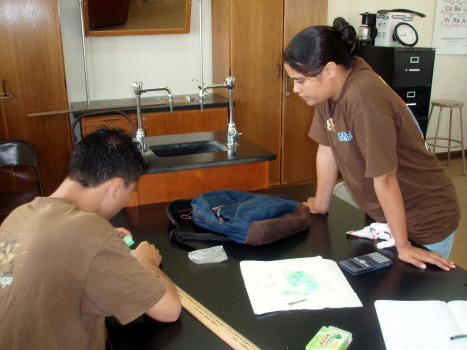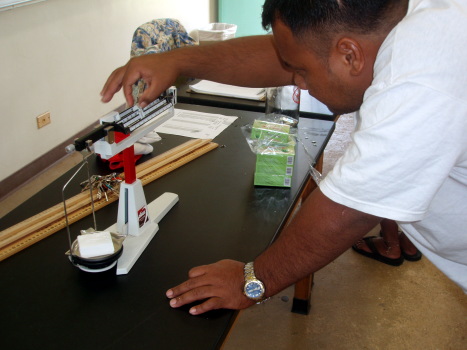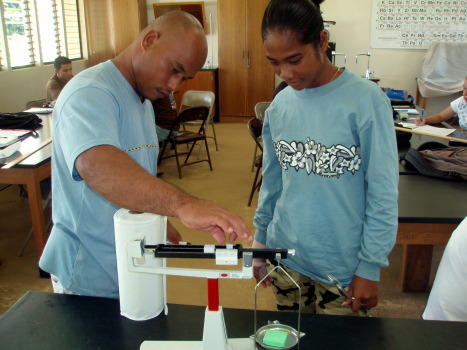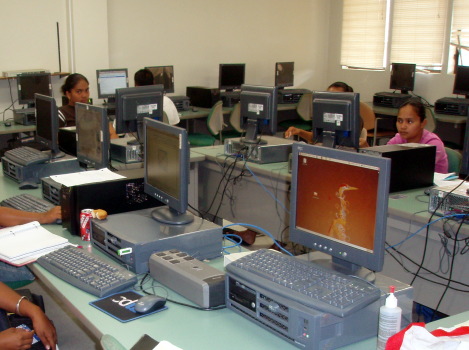
Listening intently to directions
This was the first term to carve the soap to generate a linear regression. This permitted moving the "mathematical models" material forward to the start of the term. Ongoing assessment during the fall of 2007 and the spring of 2008 had identified the need to make very explicit for the students the process of determining whether a mathematical model existed.

Listening intently to directions
By lab 08 in the spring of 2008 the students were still clearly confused. Lab 08 was redesigned to focus more attention on the knowledge gap that had been identified.

Carving with paring knives
After the spring term ended, the push was to drive regressions into the heart of as many labs as possible and to introduce these from lab one. Initial thoughts centered on determining the density of four marbles of differing sizes. This evolved rapidly into the concept of carving soap.

Measuring
Just before the term started the addition of using Ivory® soap was made. Ivory has a density less than one and floats. Other soaps, including the hand soap in use in the class, sink. This worked well in the 8:00 section. In the 11:00 section two groups had Ivory and both found densities greater than one. Some form of consistent error led to the result. I was unable to determine the source of the error.

Massing
The lab worked well, although the beauty bars were too thin and too oddly shaped to get a good, thick, rectangular slab. The Ivory started off rectangular, and this helped. The addition of other, more appropriate bars might be made.

Massing
The measurements took roughly an hour to an hour and half. Work then continued in the computer lab until the end of the period. At the end of the three hours some students were still working on their data.

Computing
Downstream plans are to slightly reconfigure the preceding Wednesday activity to include material now in lab 01, reprinted at the end of this debrief. Height, mass, age in seconds, and BMI would be retained, but framed in both the space-time-matter framework and the material below. The thought is to add these Wednesday activities as interstitial to the labs. The issue would be how to develop this material sufficiently to generate a valid text alternative on a five year time frame.
Primary measurements: A quantity that is directly measured using an measuring device or instrument. Measuring devices might include rulers, stopwatches, mass balances, protractors, and thermometers.
Calculated measurement: A quantity calculated from a mathematical combination of primary measurements.
All measurements are expressed as the combination of a number and the units of measure. Whenever I speak about a measurement in science I must say both the measurement and the units. Thus I say "Five centimeters" or "Three volts." Number and units. Together forever. Leave either one out, and the answer is incomplete and incomprehensible. Wrong.
There are two types of units of measure in science.
Fundamental units: Measurements of length, mass, and time using either the meter-kilogram-second (mks) or centimeter-gram-second (cgs) system. Fundamental units measure space, time, and the amount of matter contained in an object. In this laboratory measurements will be made using centimeters and grams. The first four laboratories will use the "cgs" system of measurement.
Derived units: Measurements expressed using arithmetic combinations of fundamental units. For example, volume is derived from multiplying together three independent measurements of length. To avoid confusion these three measures are usually described as length × width × height. All three are still measures of length. Length is the fundamental measurement. Volume is the derived measurement.
Density is another derived measurement. Density is derived from the mass divided by the volume.
Yet another example of a derived unit is the metric measure of liquid volumes, the liter. A liter is defined to be 1000 cm³. The liter is defined using a fundamental unit of length.
All measurements have limits in terms of their accuracy. There are terms used to describe these limits.
Uncertainty: the limit of our measuring tools for a single measurement, our uncertainty based on the smallest measurement our tools can accurately make. For a ruler marked in millimeters there is always at least a half a millimeter of uncertainty, often more. Some electronic devices tell you the uncertainty. Global positioning satellite (GPS) receivers usually provide an estimated uncertainty.
Precision: the average variation in multiple measurements of an experiment usually expressed using the standard deviation.
Error: the difference between the measured result and the actual value. The actual value is usually unknown, hence the error is never truly known.
Because of uncertainty in primary measurements and error, data is considered linear if the data falls roughly in a straight line. The data does not have to fall exactly in a straight line. The issue of how close data comes to a straight line is part of the study of correlation in statistics.